AMD Kaveri Review: A8-7600 and A10-7850K Tested
by Ian Cutress & Rahul Garg on January 14, 2014 8:00 AM ESTIntegrated GPU Performance: BioShock Infinite
The first benchmark in our test is Bioshock Infinite, Zero Punctuation’s Game of the Year for 2013. Bioshock Infinite uses the Unreal Engine 3, and is designed to scale with both cores and graphical prowess. We test the benchmark using the Adrenaline benchmark tool and their three default settings of Performance (1280x1024, Low), Quality (1680x1050, Medium/High) and Xtreme (1920x1080, Maximum) noting down the average frame rates and the minimum frame rates.
Bioshock Infinite, Performance Settings
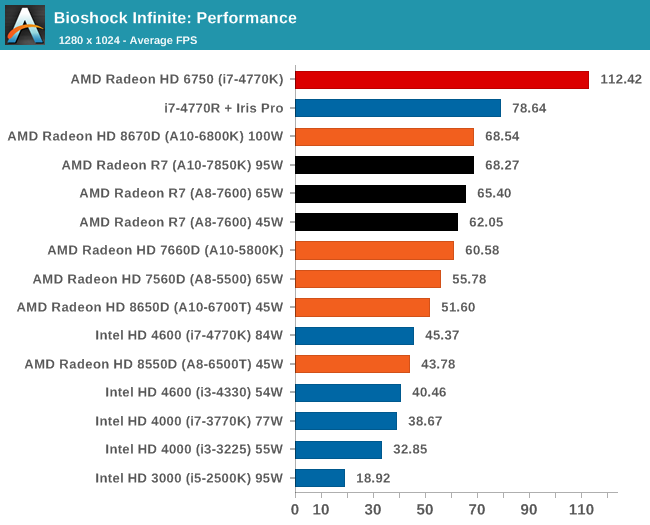
For BI: Performance we see the Iris Pro being top of the IGPs, although the next six in the list are all AMD. The Kaveri cores are all between the 6800K and 5800K for this test, and all comfortably above 60 FPS average.
Bioshock Infinite, Quality Settings

For the quality settings, the Iris Pro starts to struggle and all the R7 based Kaveri APUs jump ahead of the A10-6800K - the top two over the Iris Pro as well.
Bioshock Infinite, Xtreme Settings
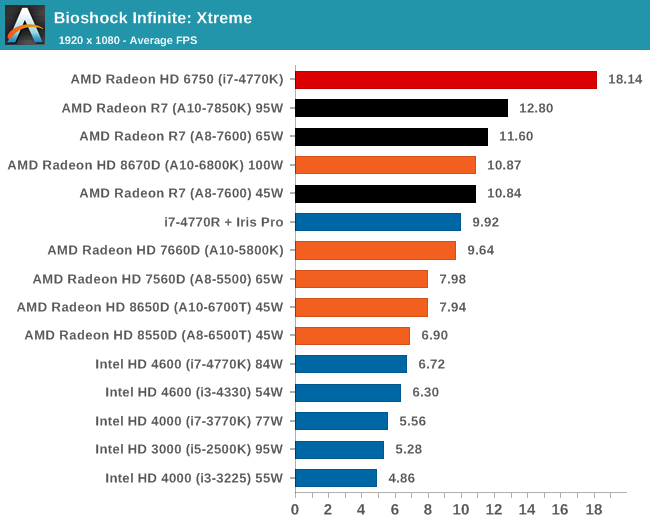
The bigger the resolution, the more the Iris Pro suffers, and Kaveri takes three out of the top four IGP results.
Integrated GPU Performance: Tomb Raider
The second benchmark in our test is Tomb Raider. Tomb Raider is an AMD optimized game, lauded for its use of TressFX creating dynamic hair to increase the immersion in game. Tomb Raider uses a modified version of the Crystal Engine, and enjoys raw horsepower. We test the benchmark using the Adrenaline benchmark tool and their three default settings of Performance (1280x1024, Low), Quality (1680x1050, Medium/High) and Xtreme (1920x1080, Maximum) noting down the average frame rates and the minimum frame rates.
Tomb Raider, Performance Settings
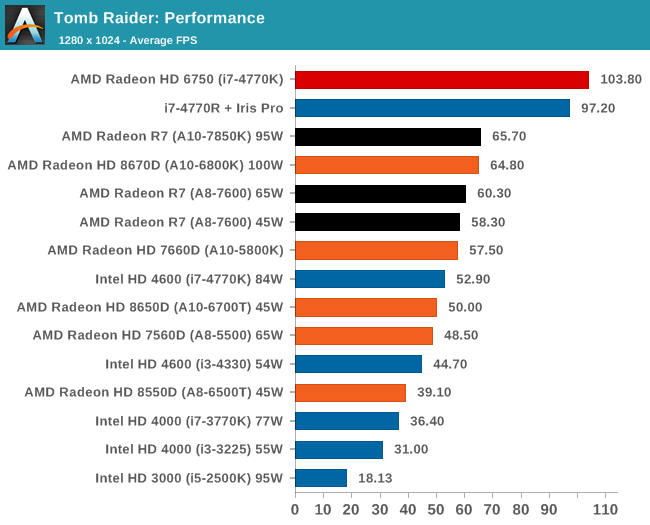
The top IGP for Richland and Kaveri are trading blows in TR.
Tomb Raider, Quality Settings

The Iris Pro takes a small lead, while the Kaveri 95W APU show little improvement over Richland. The 45W APU however is pushing ahead.
Tomb Raider, Xtreme Settings
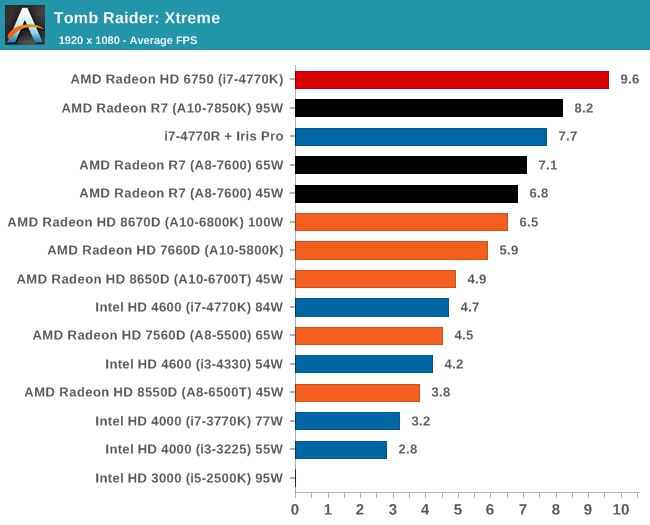
At the maximum resolution, the top Kaveri overtakes Iris Pro, and the 45W Kaveri it still a good margin ahead of the A10-6700T.
Integrated GPU Performance: F1 2013
Next up is F1 2013 by Codemasters. I am a big Formula 1 fan in my spare time, and nothing makes me happier than carving up the field in a Caterham, waving to the Red Bulls as I drive by (because I play on easy and take shortcuts). F1 2013 uses the EGO Engine, and like other Codemasters games ends up being very playable on old hardware quite easily. In order to beef up the benchmark a bit, we devised the following scenario for the benchmark mode: one lap of Spa-Francorchamps in the heavy wet, the benchmark follows Jenson Button in the McLaren who starts on the grid in 22nd place, with the field made up of 11 Williams cars, 5 Marussia and 5 Caterham in that order. This puts emphasis on the CPU to handle the AI in the wet, and allows for a good amount of overtaking during the automated benchmark. We test at three different levels again: 1280x1024 on Low, 1680x1050 on Medium and 1920x1080 on Ultra. Unfortunately due to various circumstances we do not have Iris Pro data for F1 2013.
F1 2013, Performance Settings
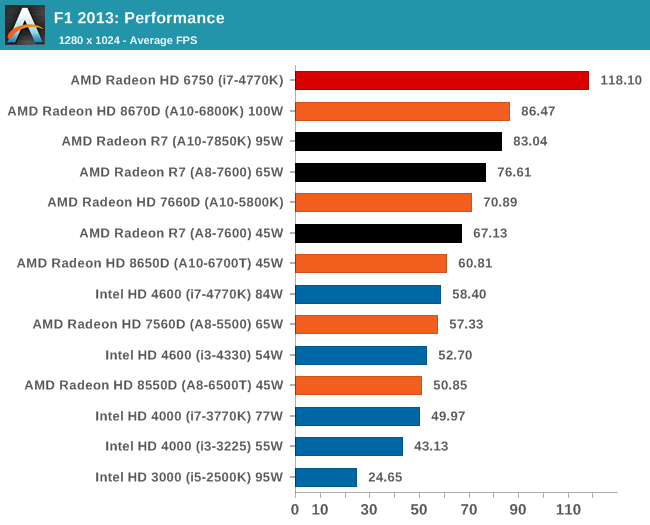
F1 likes AMD here, although moving from Kaveri to Richland at the high end seems a bit of a regression.
F1 2013, Quality Settings
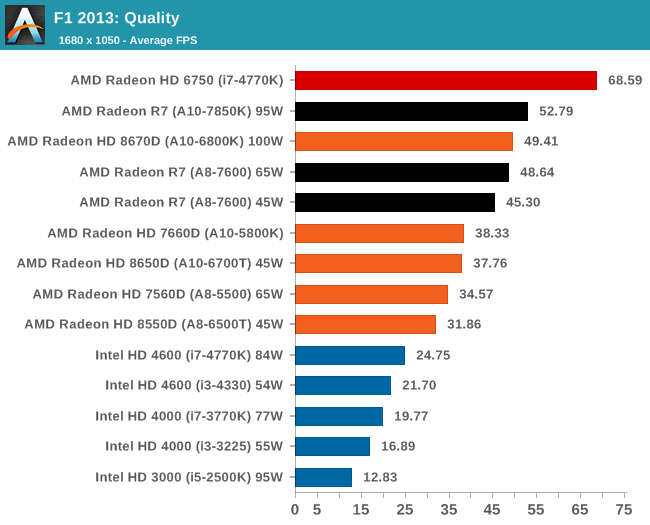
Similarly in the Quality settings, none of the Intel integrated graphics solutions can keep up with AMD, especially Kaveri.
F1 2013, Xtreme Settings

On extreme settings, at 1080p, the top Kaveri APU manages to hit over 30 FPS average during the benchmark. The other A8 Kaveri data is not too far behind.










380 Comments
View All Comments
Calinou__ - Saturday, January 25, 2014 - link
The consoles use lower level APIs, way more optimized.dsmogor - Friday, January 24, 2014 - link
From a distance the Amd architecture actually looks a lot like PS3 Cell SOC: number of CPU cores + VLIV modules that access the same bus and memory. If the GPU cores have some sort of manageable local memory (dunno) I clearly see why Sony have choosen that for their next gen.Houdhaifa - Saturday, January 25, 2014 - link
nice performanceTheyear - Sunday, January 26, 2014 - link
hixtremesv - Tuesday, January 28, 2014 - link
I'd rather give your grandpa a FX-4300 + GT640 GDDR5 roughly for the same price as A10-7850K and even better, for $20 more you ditch the FX-4300 for a FX-8120.thomascheng - Tuesday, January 28, 2014 - link
You can get the 7850K from Microcenter for 129.00 right now, its only for a limited time. I think I'll bite at the price point.neal.a.nelson - Tuesday, January 28, 2014 - link
No, that's the 6800K. The 7850K isn't even on the main AMD page.The AMD A10-7700K Unlocked Black Edition
10 Computer Cores (4 CPU + 6 GPU)
Features AMD Radeon™ R7 Graphics
AMD TrueAudio Technology for immersive audio 9
AMD A10-7700K
$159.99
REG. $179.99 045013
Buy Now!
BUNDLE & SAVE!
AMD A10-6800K
$129.99
REG. $159.99 617795
Buy Now!
BUNDLE & SAVE!
rrgg - Sunday, February 2, 2014 - link
Is there a stated release date for the A8-7600 (Kaveri)? I know it was pushed out but to when? Thanks.Novaguy - Wednesday, February 12, 2014 - link
Hmmm, any news about the a8-7600 availability? Or mobile parts?What I am really curious about is the performance of a kaveri a8 + r9-290m (aka 7970m/8970m rebadge) in a laptop (such as the msi model that was reviewed on anandtech). Will that get of the frame throttling that was going on in that msi laptop?
DoctorBurp - Thursday, February 20, 2014 - link
It is interesting to see how computers involved into having two “brains”: The CPU which works sequentially and is generally better with small amount of data, and the GPU which works parallel and is generally better with large amount of data.Us humans also tend to have two ways of thinking, and to demonstrate it let us talk about decisions making. When dealing with small amount of information we tend to take the sequential route: We investigate, write notes , explorer in depth and operate in a step by step manner it order to make the right choice. However when dealing with large amount of information it is impossible to remember each and every detail and investigating turns to be a tedious work. This is when we turn to our gut feeling, our intuition, and at the end make a decision because it “feels right”. This feeling is a result of a processing which took place backstage in areas like our sub subconscious, which as far as we know it works in a parallel way.
Since computers have been invented by humans, and for the most part reflect the way WE think, it is not surprising to find these similarities. I for instance find it fascinating and funny at the same time :) Maybe by trying to imitate the way we think we will end up understanding our self better…
Just thought of sharing it with you all.